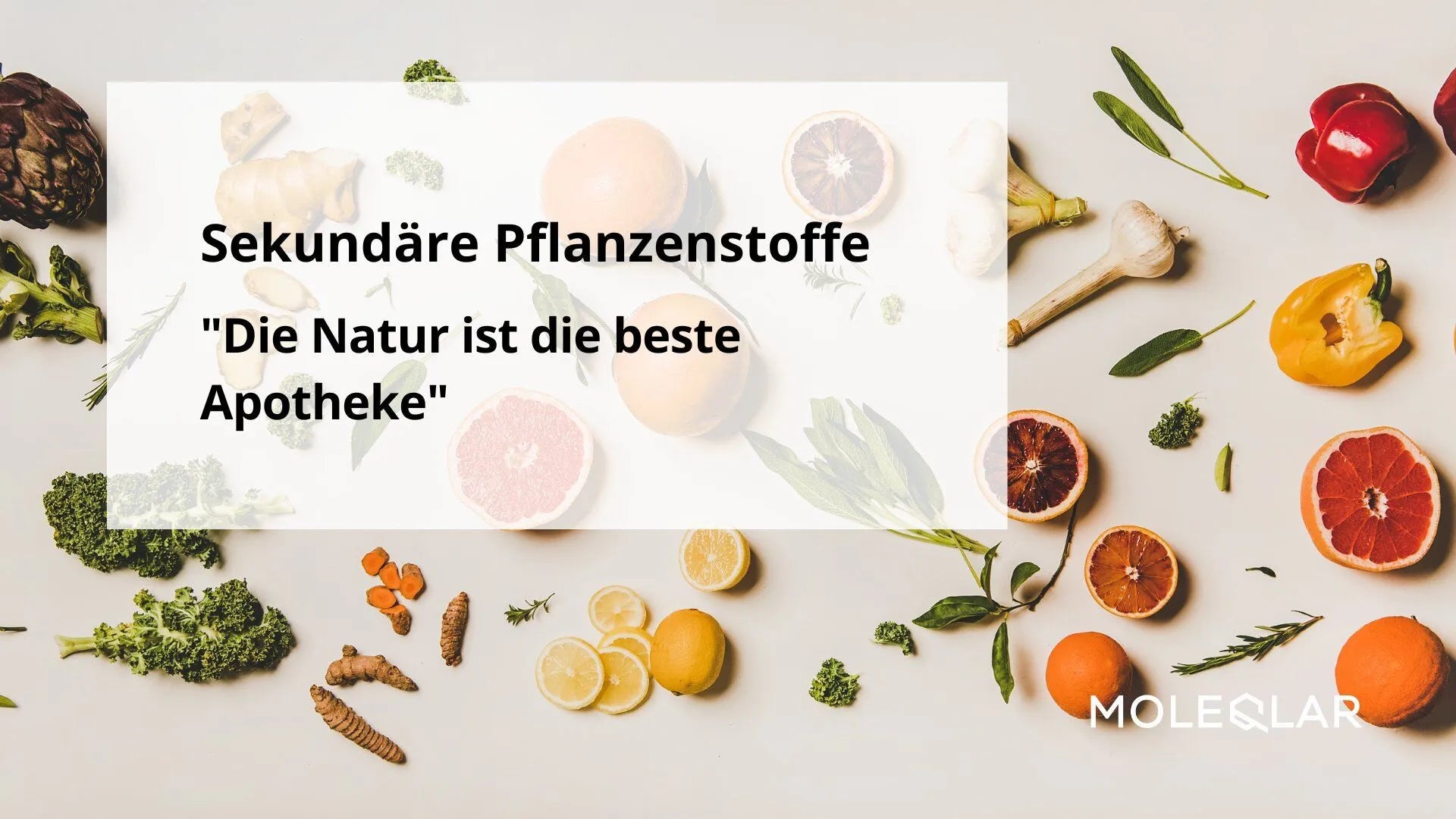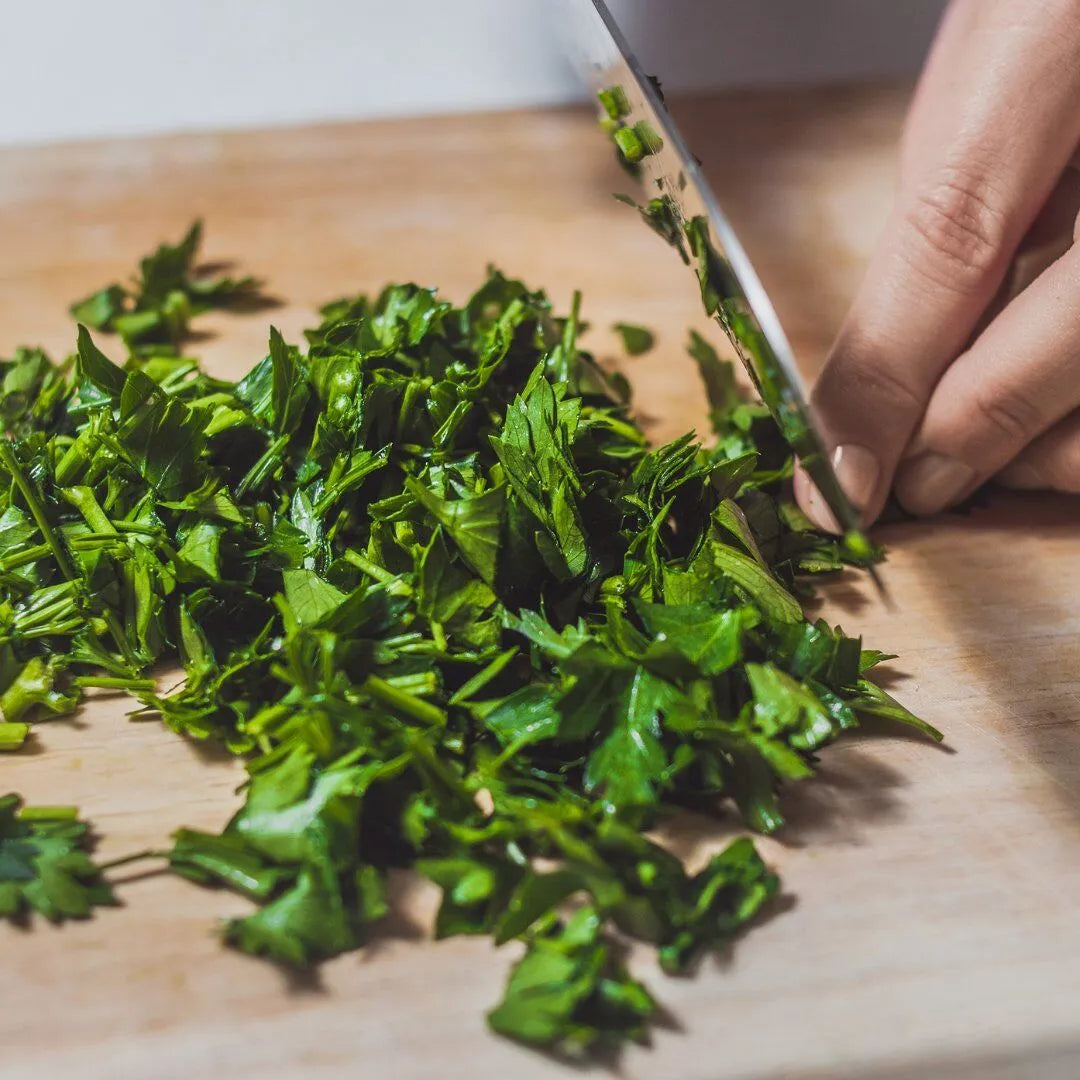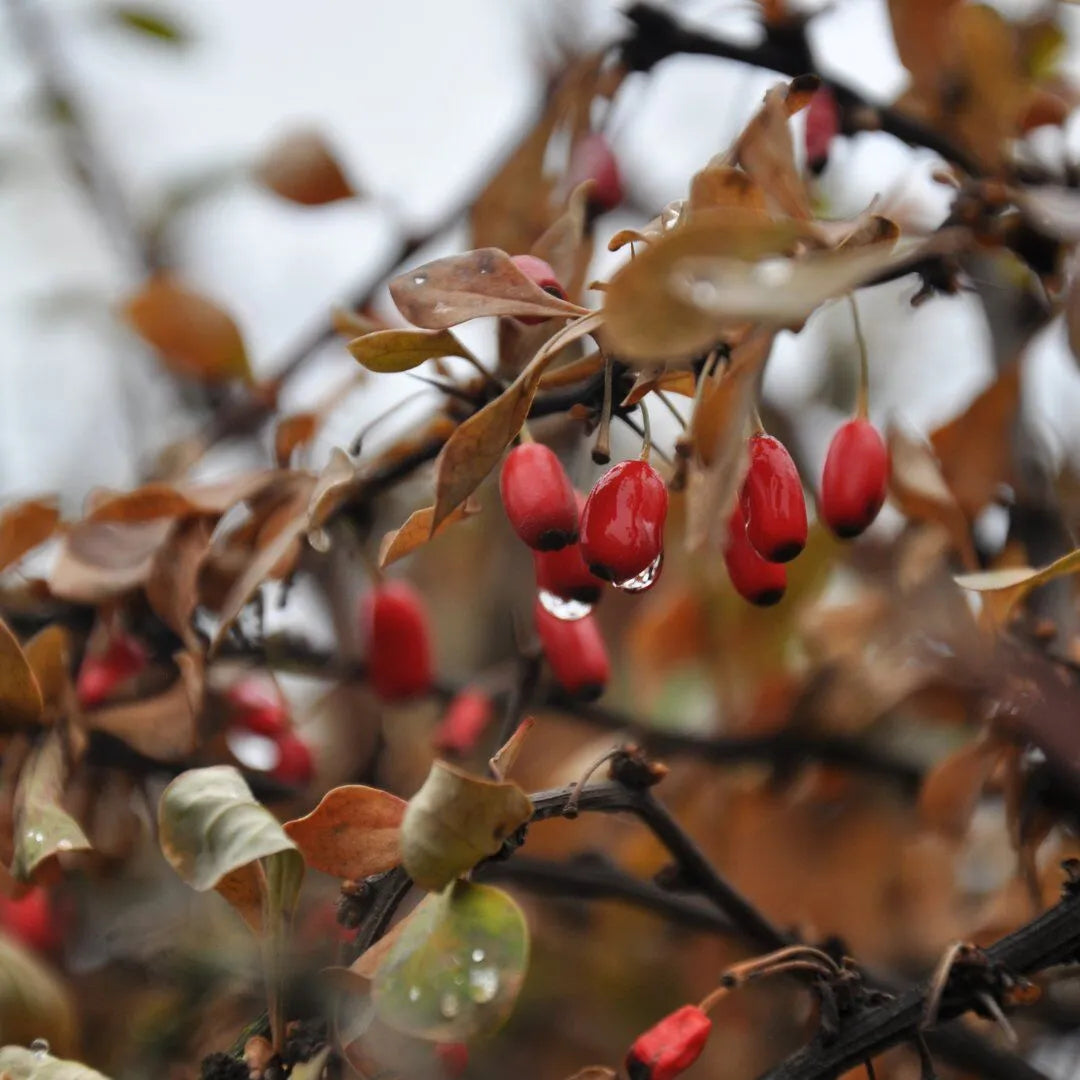Secondary plant substances

Secondary plant substances such as resveratrol, quercetin or berberine have many health-promoting properties.
Secondary plant substances: nature as the best pharmacy
Plants use certain substances to protect themselves from environmental influences such as pests or ultraviolet radiation. These bioactive molecules are known for their many health-promoting properties for us humans and are also commonly referred to as secondary plant substances .
Are there also primary plant substances? Yes, these include carbohydrates, proteins and fats - in contrast to secondary plant substances, they are directly involved in the metabolic activity or growth of plants. Secondary plant substances, on the other hand, fulfill the protective functions mentioned aboveThe "wilder" plants have grown, the higher the concentration of secondary plant substances.

You are what you eat - or are you?
Plants signal their numerous healthy ingredients to us with their bright colors. The shimmering blue of blueberries, caused by anthocyanins, a subgroup of flavonoids, promises strong antioxidant effects. Other flavonoids can be found in the crunchy skin of apples, or in the colorful peppers. Red grapes contain the ingredient resveratrol and broccoli contains glucosinolates.
All these substances can be summarized in the supergroup "secondary plant substances". They are responsible for a large part of the health-promoting effect of fruit and vegetables.
Nature as inspiration for medicines
Scientists have always used nature as a source of inspiration for possible medicines. ASA originally comes from the bark of willow trees, painkillers come from the dried milky sap of the opium poppy and certain cancer drugs are extracted from the Pacific yew tree.
Many other drugs are further developments of molecules found in nature. For example, the oldest naturally occurring antibiotic has been continuously developed by attaching molecular structures and thus generating new antibiotics.
What are phytochemicals
Secondary plant substances are chemical compounds that occur in plants and mainly perform protective functions. They do not play a fundamental role in the metabolism of plants - this task is performed by "primary" plant substances such as carbohydrates, proteins and fats. While the primary substances can be counted on one hand, the secondary plant substances are incredibly diverse.
A total of around 100,000 different ones are known to date. Of these, around 5,000 to 10,000 are found in human food. The various phytochemicals can be divided into different groups based on their chemical structure and functional properties. These groups include polyphenols, flavonoids, alkaloids, glucosinolates, polyamines and many more. The effects of the particular molecules in the human body differ depending on their chemical structure.
Chlorophyll and phytic acid also belong to the secondary plant substances, but cannot be assigned to a definitive group.
In recent decades, knowledge about the importance of secondary plant substances for human health has increased dramatically. After many smaller studies, large prospective observational studies (cohort studies) and intervention studies with isolated phytochemicals have been carried out. A few years ago it was still unclear whether the effects were based on the interaction of different molecules or whether individual substances were responsible. Research has shed light on this in particular. What is certain is that a diet rich in phytochemicals improves many health indicators.
Importance of phytochemicals for the plant world and their effects on human health
Before we look at the effects in the body, let's take a look at the functions in the plant world. The main task of phytochemicals is to protect plants from harmful influences. They serve as natural defense mechanisms against herbivorous insects, fungi, bacteria and other pathogens.
They can also help protect flora from UV radiation, heat, cold and other environmental stressors.
Based on these remarkable properties, researchers have wondered whether some of the effects can be transferred to humans, especially since many of the plants are in our diet. Thousands of studies later, we know the encouraging answer.
Many phytochemicals have been shown to have antioxidant properties, which means that they can fight free radicals and reduce oxidative damage in the body.
Free radicals are unstable molecules that arise in our bodies as a result of various factors such as environmental pollution, stress, smoking and an unhealthy diet. A certain minimum level of "oxidative stress" is actually essential for survival (including for our immune system). However, an excess of free radicals causes cell damage and is therefore associated with chronic problems such as heart disease and neurodegenerative diseases.
In addition, certain phytochemicals can reduce inflammation and strengthen the immune system. They also improve blood circulation and support bone health.
What types of phytochemicals are there?

Grapes in particular are especially rich in resveratrol - probably the best-known polyphenol.
Polyphenols
Polyphenols are one of the largest groups. They are found in almost all plants, from berries and spinach to oatmeal and walnuts.
Green tea contains a special subgroup of polyphenols, the catechins. These include the complicated-sounding molecule epigallocatechin gallate, or EGCG. EGCG has been shown in animal studies to be effective against high blood sugar, in the prevention of neurodegenerative diseases and in the lowering of cholesterol levels.
Another polyphenol is resveratrol, which is abundant in red grapes. You may have heard of the French paradox . Despite a high-fat diet with high nicotine consumption, French people seemed to live longer. This is partly attributed to the high polyphenol content of some wine varieties, such as Pinot Noir. One of the best-known researchers on resveratrol is Harvard Professor Dr. David Sinclair.
The following foods are rich in polyphenols
- Spices and herbs: Spices such as cloves, star anise and peppermint as well as dried herbs are particularly rich in polyphenols.
- Dark chocolate and cocoa: Dark chocolate and pure cocoa powder are excellent sources of polyphenols.
- Berries: Blueberries, blackberries and other types of berries contain high amounts of polyphenols.
- Fruits and vegetables: Apples, pears, grapes, onions, beets and kale are some of the fruits and vegetables that are rich in polyphenols.
- Nuts: Nuts, especially walnuts and hazelnuts, are good sources of polyphenols.
- Whole grains: Whole grain cereals and breads can also provide significant amounts of polyphenols.
- Pulses: Pulses such as beans and lentils are also rich in these beneficial compounds.
- Tea, coffee and red wine: These drinks are known for their high content of polyphenols. Green tea is particularly rich in catechins.
- Olive oil: Extra virgin olive oil is an excellent source of polyphenols.

The flavonoid apigenin is hidden in parsley in comparably large quantities. According to studies, it can support NAD levels.
Flavonoids
Strictly speaking, flavonoids also belong to the polyphenols.
Apigenin occurs naturally in some herbs, such as parsley or coriander. However, chamomile and celery also contain apigenin. In higher concentrations, this molecule can keep NAD levels high by inhibiting the enzyme CD38 . Higher NADlevels are associated with increased healthspan.
In addition to apigenin, luteolin also interferes with NAD metabolism. Luteolin, which is mainly found in olive oil, rosemary, thyme and carrots, also has a positive effect on the longevity genes, the so-called sirtuins.
Quercetin, the third representative in the group, supports the immune system and can have a positive effect on allergies. The flavonoid can also promote the breakdown of old cells that are no longer dividing. The process is also known as senolysis.
More on this topic: What is quercetin?
What is regeNAD (with luteolin and apigenin)?
The following foods are rich in flavonoids
- Berries: Blueberries, blackcurrants and blackberries are rich in a type of flavonoid called anthocyanins.
- Onions and cabbage: These vegetables are good sources of flavanols, a subclass of flavonoids.
- Wine grapes and red wine: Both contain high amounts of flavonoids, especially when the grape skin is involved.
- Tea: Both green and black tea are rich in several types of flavonoids.
- Apples and pears: These fruits are good sources of several types of flavonoids.
- Soy products: Soy contains isoflavones, a special type of flavonoid.
- Peaches, tomatoes and lettuce
- Citrus fruits: Grapefruits, lemons and oranges are rich in flavonoids.
- Many herbs and spices: These include parsley, thyme and celery.
The amount and type of flavonoids in foods can vary depending on factors such as ripeness, storage and preparation. Here too, it is important to pay attention to high purity and independent manufacturer certificates when looking for appropriate food supplements.

The alkaloid berberine accumulates in the well-known barberry plants. It is a great natural hope for blood sugar research.
Alkaloids
Alkaloids are characterized by at least one nitrogen atom in a ring structure. There are many different alkaloids, which have different properties depending on their molecular structure. You will certainly be familiar with some of them. Caffeine belongs to this group, as does the painkiller morphine.
Another representative is berberine, which is found in various plants such as barberry. In addition to its anti-inflammatory properties and its long-standing use in Chinese medicine, the effect of berberine on blood sugar is currently being investigated. Some studies have found comparable positive effects on blood sugar and insulin sensitivity as with prescription diabetes medication.
Known alkaloids and their use
The best-known alkaloids include:
- Morphine: It is the main alkaloid of the opium poppy and is used as a powerful painkiller.
- Caffeine: This alkaloid, which is found in coffee, tea and some other plants, is a central nervous system stimulant.
- Nicotine: It is the additive in tobacco and e-cigarettes and has strong stimulating and relaxing effects - but also an enormously high addictive potential.
- Quinine: This alkaloid, which is extracted from the bark of the cinchona tree, has traditionally been used to treat malaria.
Berberine, the main alkaloid in Berbersome, has long been used in traditional Chinese medicine to treat digestive problems and infections. It also plays a role in sugar metabolism and is therefore a beacon of hope for diabetes research.

Broccoli (especially the sprouts) is particularly rich in glucoraphanin - the direct precursor of sulforaphane.
Glucosinolates
Green vegetables, especially broccoli and spinach, contain another group of phytochemicals: glucosinolates. To be more precise, they contain the substance glucoraphanin. This is converted into sulforaphane with the help of an enzyme, which contributes to the slightly bitter taste of these vegetables.
Sulforaphane, like almost all phytochemicals, has antioxidant and anti-inflammatory properties. The other effects in the body are interesting. According to studies, sulphoraphane can lower blood pressure and help the liver to detoxify via the Nrf2 pathway.
Glucosinolates in food
Glucosinolates are found in many types of cruciferous vegetables, including:
- Brokkoli
- Blumenkohl
- Kohl
- Rosenkohl
- Radieschen
- Rucola
- Gartenkresse
- Senf
- Meerrettich

The polyamine with the special name is hidden in soybeans and wheat germ. We are talking about spermidine.
Polyamines
Polyamines occupy a special position. Depending on the definition, they belong to the extended group of secondary plant substances. One of the best-known representatives is the molecule spermidine, which is responsible for cell division and stress tolerance in plants.
It is found in large quantities in soya and wheat germ , for example. It is currently being further researched in humans due to its ability to increase autophagy. Based on the latest research results, it is assumed thatspermidine has similar positive effects on the body as fasting . In addition, spermidine appears to offer protection against neurodegenerative and cardiovascular diseases through improved autophagy.
Polyamines in food
Foods that are particularly rich in polyamines include:
- Meat and fish
- Certain cheeses, such as cheddar and gouda
- Soybeans & Chlorella algae (see spermidine)
- Fermented foods such as sauerkraut and kimchi
- Yeast and yeast extracts
Highly pure, concentrated secondary plant substances from MoleQlar
"An apple a day, keeps the doctor away" - what's behind the metaphor?
Is the old saying "An apple a day keeps the doctor away" still true today? According to the studies, this is doubtful. Industrial agriculture allows us to produce large quantities of food, but this is often at the expense of nutrients.
It is not the macronutrients - carbohydrates, fats and proteins - that remain unchanged, it is primarily about micronutrients. Some studies have shown that the vitamin C content of an apple from conventional farming is up to 50% lower than from organic farming. In addition, other secondary plant substances such as flavonoids are significantly reduced.
Bioavailability of phytochemicals
By definition, bioavailability refers to the extent and speed at which an active ingredient is absorbed by the body and reaches its site of action. This proportion is often low for plant-based foods, including phytochemicals. However, various factors can improve absorption.
In the case of polyphenols, for example, bioavailability appears to be improved by physiological quantities, exposure to heat and particle size reduction (e.g. grinding) during processing. In addition, the presence or absence of certain nutrients can influence the bioavailability of polyphenols. For example, a higher fat content and the presence of other polyphenols can increase the bioavailability of polyphenols, while the presence of proteins and antioxidants (vitamins C and E) appears to reduce gastrointestinal degradation. As far as vitamins are concerned, however, the research results are mixed.
These fundamental findings were also the basis for the development of food supplements. Extracting or isolating the substances from the plants not only enables a higher concentration, but also greater purity. If the pure substances are then also paired with phospholipids, this results in significantly increased availability for our body.
Find out more about phospholipidshere.
Possible side effects of an overdose of phytochemicals
Secondary plant substances, including the well-known flavonoids, have numerous health benefits - but there are a few things to consider when it comes to dosage. An overdose can have various consequences.
- Changes in hormone activity: Some secondary plant substances, such as isoflavones, can influence the activity of hormones in the body. Isoflavones from soy and red clover are similar in structure to estrogens and can therefore interact with the corresponding receptors in the body. At very high intakes, they can upset the hormonal balance.
- Interactions with medications: Secondary plant substances can interact with certain medications via the CYP450 system of the liver and alter their effectiveness. For example, flavonoids can affect blood clotting and increase the risk of bleeding in people taking blood-thinning medication.
- Toxicity: Although very rare, some phytochemicals can be toxic in high doses. For example, high doses of capsaicin, the phytochemical that gives chili peppers their heat, can cause gastrointestinal discomfort.
- Allergic reactions: In some people, phytochemicals can trigger allergic reactions, especially when consumed in high quantities.
It is generally the case that the amount of phytochemicals consumed in a normal diet is usually safe. Problems usually arise from the improper or excessive use of food supplements. Therefore, follow the dosage recommendations on the packaging and talk to your trusted doctor beforehand if you are taking medication.

Sources
Literature:
- Baska, A., Leis, K., & Gałązka, P. (2021). Berberine in the Treatment of Diabetes Mellitus: A Review. Endocrine, metabolic & immune disorders drug targets, 21(8), 1379-1386.
- Batiha, G. E., Beshbishy, A. M., Ikram, M., Mulla, Z. S., El-Hack, M. E. A., Taha, A. E., Algammal, A. M., & Elewa, Y. H. A. (2020). The Pharmacological Activity, Biochemical Properties, and Pharmacokinetics of the Major Natural Polyphenolic Flavonoid: Quercetin. Foods (Basel, Switzerland), 9(3), 374.
- Boyer, J., & Liu, R. H. (2004). Apple phytochemicals and their health benefits. Nutrition journal, 3, 5.
- Chen, A. Y., & Chen, Y. C. (2013). A review of the dietary flavonoid, kaempferol on human health and cancer chemoprevention. Food chemistry, 138(4), 2099-2107.
- Dixon, M., Woodrick, J., Gupta, S., Karmahapatra, S. K., Devito, S., Vasudevan, S., Dakshanamurthy, S., Adhikari, S., Yenugonda, V. M., & Roy, R. (2015). Corrigendum to "Naturally occurring polyphenol, morin hydrate, inhibits enzymatic activity of N-methylpurine DNA glycosylase, a DNA repair enzyme with various roles in human disease" [Bioorg. Med. Chem. 23 (2015) 1102-1111]. Bioorganic & medicinal chemistry, 23(15), 5077.
- Erb, M., & Kliebenstein, D. J. (2020). Plant Secondary Metabolites as Defenses, Regulators, and Primary Metabolites: The Blurred Functional Trichotomy. Plant physiology, 184(1), 39-52.
- Erlund, I., Meririnne, E., Alfthan, G., & Aro, A. (2001). Plasma kinetics and urinary excretion of the flavanones naringenin and hesperetin in humans after ingestion of orange juice and grapefruit juice. The Journal of nutrition, 131(2), 235-241.
- Frank, A. M., Pesavento, J. J., Mizzen, C. A., Kelleher, N. L., & Pevzner, P. A. (2008). Interpreting top-down mass spectra using spectral alignment. Analytical chemistry, 80(7), 2499-2505.
- García-Mier, L., Guevara-González, R. G., Mondragón-Olguín, V. M., Del Rocío Verduzco-Cuellar, B., & Torres-Pacheco, I. (2013). Agriculture and bioactives: achieving both crop yield and phytochemicals. International journal of molecular sciences, 14(2), 4203-4222.
- Goetz, M. E., Judd, S. E., Hartman, T. J., McClellan, W., Anderson, A., & Vaccarino, V. (2016). Flavanone Intake Is Inversely Associated with Risk of Incident Ischemic Stroke in the REasons for Geographic and Racial Differences in Stroke (REGARDS) Study. The Journal of nutrition, 146(11), 2233-2243.
- Guo, L., Winzer, T., Yang, X., Li, Y., Ning, Z., He, Z., Teodor, R., Lu, Y., Bowser, T. A., Graham, I. A., & Ye, K. (2018). The opium poppy genome and morphinan production. Science (New York, N.Y.), 362(6412), 343-347.
- Jennings, P. H., Brannaman, B. L., & Zscheile, F. P., Jr (1969). Peroxidase and polyphenol oxidase activity associated with Helminthosporium leaf spot of maize. Phytopathology, 59(7), 963-967.
- Kalt, W., Cassidy, A., Howard, L. R., Krikorian, R., Stull, A. J., Tremblay, F., & Zamora-Ros, R. (2020). Recent Research on the Health Benefits of Blueberries and Their Anthocyanins. Advances in nutrition (Bethesda, Md.), 11(2), 224-236.
- Kazemi-Dinan, A., Thomaschky, S., Stein, R. J., Krämer, U., & Müller, C. (2014). Zinc and cadmium hyperaccumulation act as deterrents towards specialist herbivores and impede the performance of a generalist herbivore. The New phytologist, 202(2), 628-639.
- Kumar, A., P, N., Kumar, M., Jose, A., Tomer, V., Oz, E., Proestos, C., Zeng, M., Elobeid, T., K, S., & Oz, F. (2023). Major Phytochemicals: Recent Advances in Health Benefits and Extraction Method. Molecules (Basel, Switzerland), 28(2), 887.
- Kwon, S. C., Yi, H., Eichelbaum, K., Föhr, S., Fischer, B., You, K. T., Castello, A., Krijgsveld, J., Hentze, M. W., & Kim, V. N. (2013). The RNA-binding protein repertoire of embryonic stem cells. Nature structural & molecular biology, 20(9), 1122-1130.
- Langlais, P. J., McRee, R. C., Nalwalk, J. A., & Hough, L. B. (2002). Depletion of brain histamine produces regionally selective protection against thiamine deficiency-induced lesions in the rat. Metabolic brain disease, 17(3), 199-210.
- Littlejohns, C. G., Nedeljkovic, M., Mallinson, C. F., Watts, J. F., Mashanovich, G. Z., Reed, G. T., & Gardes, F. Y. (2015). Next generation device grade silicon-germanium on insulator. Scientific reports, 5, 8288.
- Mlcek, J., Jurikova, T., Skrovankova, S., & Sochor, J. (2016). Quercetin and Its Anti-Allergic Immune Response. Molecules (Basel, Switzerland), 21(5), 623.
- Montgomery, D. R., & Biklé, A. (2021). Soil health and nutrient density: Beyond organic vs. conventional farming. Frontiers in Sustainable Food Systems, 5, 699147.
- Neduva, A.kanevsky, M., & Lerner, V. (2012). Perverse political correctness and personality traits. Medical hypotheses, 78(1), 146-150.
- Nógrádi, M., Farkas, L., & Olechnowicz-Stepien, V. (1971). Synthesis of flavonoid-bis-glycosides, IV. Synthesis of quercetin-3-alpha-L-rhamnopyranoside-7-beta-D-glucopyranoside and quercetin-3-beta-D-xylopyranoside-7-beta-D-glucopyranoside, two flavonoid-bis-glycosides from Evonymus species [Synthesis of flavonoid-bis-glycosides. IV. Synthesis of quercetine-3-alpha-L-rhamnopyranoside-7-beta-D-glucopyranoside and quercetine-3-beta-D-xyclopyranoside, 2 flavone-bis-glycosides from Evonymus species]. Chemical Reports, 104(11), 3618-3620.
- Pandey, K. B., & Rizvi, S. I. (2009). Plant polyphenols as dietary antioxidants in human health and disease. Oxidative medicine and cellular longevity, 2(5), 270-278.
- Skrovankova, S., Sumczynski, D., Mlcek, J., Jurikova, T., & Sochor, J. (2015). Bioactive Compounds and Antioxidant Activity in Different Types of Berries. International journal of molecular sciences, 16(10), 24673-24706.
- Tomimori, T., Jin, H., Miyaichi, Y., Toyofuku, S., & Namba, T. (1985). Yakugaku zasshi : Journal of the Pharmaceutical Society of Japan, 105(2), 148-155.
- Weaver B. A. (2014). How taxol/paclitaxel kills cancer cells. Molecular biology of the cell, 25(18), 2677-2681.
- Zhou, X., Liu, X., Liao, W., Wang, Q., & Xia, W. (2023). Corrigendum to: "Chitosan/bacterial cellulose films incorporated with tea polyphenol nanoliposomes for silver carp preservation" [Carbohydr. Polym. 297 (2022) 120048]. Carbohydrate polymers, 301(Pt B), 120297.
- Zou, D., Zhao, Z., Li, L., Min, Y., Zhang, D., Ji, A., Jiang, C., Wei, X., & Wu, X. (2022). A comprehensive review of spermidine: Safety, health effects, absorption and metabolism, food materials evaluation, physical and chemical processing, and bioprocessing. Comprehensive reviews in food science and food safety, 21(3), 2820-2842.










































